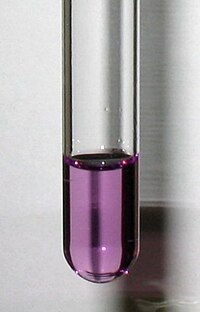
Photo from wikipedia
Two copper(ii)-based layered complexes with or without the amino group, [Cu(HL)2(NH2-BDC)]n (1) and [Cu(HL)2(BDC)]n (2) (HL = 4'-(4-hydroxyphenyl)-4,2':6',4''-terpyridine, NH2-H2BDC = 2-amino-1,4-benzenedicarboxylic acid and H2BDC = 1,4-benzenedicarboxylic acid), were solvothermally synthesized… Click to show full abstract
Two copper(ii)-based layered complexes with or without the amino group, [Cu(HL)2(NH2-BDC)]n (1) and [Cu(HL)2(BDC)]n (2) (HL = 4'-(4-hydroxyphenyl)-4,2':6',4''-terpyridine, NH2-H2BDC = 2-amino-1,4-benzenedicarboxylic acid and H2BDC = 1,4-benzenedicarboxylic acid), were solvothermally synthesized and used as photocatalysts to accelerate hydrogen production from water splitting. The amino group modified 1 has exhibited greatly enhanced photocatalytic activity with a hydrogen production rate of 2.34 mmol g-1 h-1 under visible light irradiation, which is almost double that of 2. Density functional theory calculations, electrochemical impedance spectroscopy and transient photocurrent tests demonstrate that the higher catalytic activity of 1 than 2 is a result of the enriched electron density around the CuII center by the amino group, which facilitates the charge transfer from the conduction band to the water molecule.
Journal Title: Dalton transactions
Year Published: 2018
Link to full text (if available)
Share on Social Media: Sign Up to like & get
recommendations!